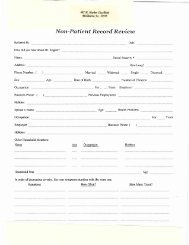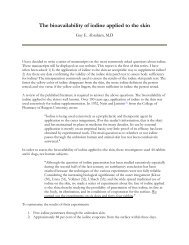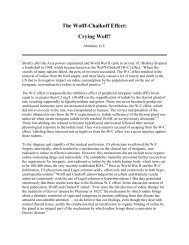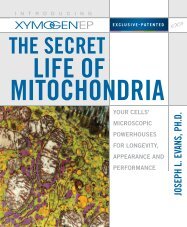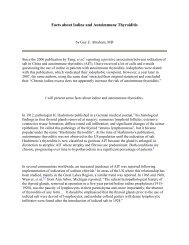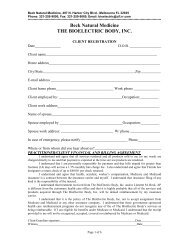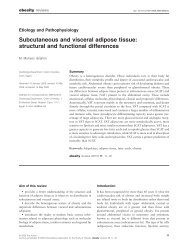Johns Hopkin's Brassica SGS I - Beck Natural Medicine University
Johns Hopkin's Brassica SGS I - Beck Natural Medicine University
Johns Hopkin's Brassica SGS I - Beck Natural Medicine University
You also want an ePaper? Increase the reach of your titles
YUMPU automatically turns print PDFs into web optimized ePapers that Google loves.
sgs"<br />
Ilistory:<br />
ln 1992, scientists at <strong>Johns</strong> Hopkins <strong>University</strong> School of <strong>Medicine</strong> identified sulforaphane as a naturally-occurring<br />
compound in broccoli that possesses antioxidant activity. It appeared to be responsible for the epidemiological<br />
findings that diets rich in cruciferous vegetables are correlated with lower levels of cancer. These scientists<br />
subsequently determined that the compound present in the broccoli plant was the glucosinolate precursor of<br />
sulforaphane - known as glucoraphanin or "<strong>SGS</strong>".<br />
ln 1997,this research group demonstrated that the <strong>SGS</strong> content of mature broccoli is highly variable and <strong>SGS</strong> is<br />
present at much higher concentrations in three-day-old broccoli sprouts. (73 mg v. l l mg per serving, in mature<br />
broccoli.) Alternately stated: one ounce of broccoli sprouts contains as much <strong>SGS</strong> as over l-ll4 pounds (20 ounces)<br />
of market-stage broccoli.<br />
Since 1992, <strong>SGS</strong> has been extensively studied at <strong>Johns</strong> Hopkins and other prestigious medical institutions around<br />
the globe. More than 400 studies have been published which support its possible health benefit.<br />
What Does <strong>SGS</strong> Do?<br />
<strong>SGS</strong> is multidimensional. Not only does it work as a potent catalyst to boost Phase 2 enzymes that detoxify<br />
potential carcinogens and to trigger ongoing antioxidant action for at least 72 hours - (significantly longer than that<br />
of direct antioxidants such as vitamins C, E and beta carotene); but researchers in France identified sgs's likely<br />
ability to induce apoptosis and cell cycle arrest in cells with potential cancer-causing mutations.(ref) In addition,<br />
research has demonstrated powerful and selective antibacterial properties (ref), as well as beneficial effects upon<br />
cardiovascular and eye health.(refs)<br />
Research<br />
The body of scientific knowledge concerning <strong>SGS</strong> and broccoli sprouts continues to grow at a rapid rate; key<br />
studies with respect to <strong>SGS</strong> are summarized below. Although research suggests a promising role for <strong>SGS</strong> in<br />
promoting health, the research results do not permit definitive scientific conclusions on specific health benefits. At<br />
this time, the U.S. FDA has not reached any such conclusions or authorized any claims specifically for <strong>SGS</strong> or<br />
broccoli sprouts.<br />
Summaries of some kev studies follow:<br />
CANCER:<br />
C arcinogen Detoxification<br />
Potential to detoxify carcinogens. An elevated level of hepatitis virus and environmental toxins results in a very<br />
high prevalence of liver cancer in a rural area of China. Scientists from <strong>Johns</strong> Hopkins <strong>University</strong> and Qidong Liver<br />
Cancer Institute performed a clinical test to assess whether broccoli sprouts influenced the body's abilities to<br />
detoxify carcinogens. In a single-blinded, placebo-controlled trial, 100 test and 100 control subjects drank a water<br />
extract of 3-day-old broccoli sprouts or a placebo daily over a period of two weeks. The broccoli sprouts group<br />
showed a significant decrease in aflatoxin-DNA adduct (a biomarker of DNA damage) levels with increasing levels<br />
For distribution to Medical Professionals only
of broccoli sprout consumption. The change in these biomarkers signals an enhanced detoxification (neutralization)<br />
of carcinogens from the human body leading to a reduction in cancer risk.<br />
-Cancer Epidemiologt, Biomarkers Prevention, 2005 ; I a(l 1).<br />
Tumor Progression and Activity<br />
The inhibition of lung cancer tumors. Scientists at Georgetown <strong>University</strong> Medical Center reported that<br />
sulforaphane and another isothiocyanate (PEITC) could prevent initial benign tumors in the lungs of mice produced<br />
by a cigarette carcinogen from developing into malignant cancer tumors. Using a model in which the animals were<br />
exposed to the carcinogens, scientists demonstrated that sulforaphane inhibits the progression ofthe disease by<br />
causing the programmed death of the damaged cells. Findings suggest that chemoprotective agents might be useful<br />
among people exposed to tobacco carcinogens, including current smokers, ex-smokers or those exposed to secondhand<br />
smoke.<br />
-Cancer Research, 2006, 65 (18):8538-8547.<br />
Stomach Cancer<br />
Suppression of H. pylori infection. Infection with the bacterium H. pylori can cause stomach ulcers and markedly<br />
increases the risk of developing stomach cancer. In vitro and animal experiments by a <strong>Johns</strong> Hopkins research<br />
team, led by Dr. Jed Fahey, showed potent and selective antibacterial properties of sulforaphane and sulforaphane's<br />
ability to selectively target Ihe H. pylori bacteria, which are often difficult to eradicate. Also, sulforaphane was<br />
effective against H. pylori strains that had developed resistance to the typical antibiotic treatment. In a Japanese<br />
study involving patients infected with FL pylori bacteria, patients eating 100 grams (approximately 3-112 ounces) of<br />
broccoli sprouts daily for 2 months experienced substantially reduced measures of H. pylori infection when<br />
compared with control subjects fed a vegetable with no <strong>SGS</strong>. These results suggest that <strong>SGS</strong> from broccoli sprouts<br />
may be responsible for the reduction of the bacteria and that a diet rich in <strong>SGS</strong> may be useful in reduction of 1L<br />
pylori infection and chemoprevention against gastric cancer.<br />
Natl. Acad. Sci. USA, 2002, 99(11):7610-7615.<br />
-Proe<br />
Epidemiology, Biomarkers & Prevention, 2005, l4(11.2): 2754s.<br />
-Cancer<br />
Skin Tumors<br />
Skin tumor formation afier exposure to UV radiation. Mice were exposed to damaging levels of UV light for 20<br />
weeks in a study conducted at <strong>Johns</strong> Hopkins Medical School. Following the exposure, application of sulforaphane<br />
resulted in a 50 percent reduction in the number of mice with tumors. The number of tumors per mouse and the<br />
mass of tumors were also reduced. A significant aspect of the study is that administration of the chemoprotective<br />
agent was after carcinogen exposure, suggesting an ability to prevent the progression of cancer after cells are<br />
already damaged.<br />
Epidemiologt, Biomarkers<br />
-Cancer<br />
& Prevention, 2005, 14(1i').<br />
Letters. 2 006. 240 : 24 3-2 52.<br />
-Cancer<br />
Research. 2006. 66: 8293-8296.<br />
-lancer<br />
Breast Cancer<br />
Work from Dr. Paul Talalay's lab at <strong>Johns</strong> Hopkins, published in 1994, demonstrated chemoprotective effects of<br />
sulforaphane, showing its ability to reduce mammary tumor formation in rats. Scientists at Shanghai Cancer Center<br />
in China conducted a retrospective (epidemiological) study of 350 pairs of women. One of each pair had breast<br />
cancer. The other was cancer-free. The study results revealed that women who had eaten higher levels of <strong>Brassica</strong><br />
vegetables<br />
- broccoli, cabbage, cauliflower and kale- all of which contain <strong>SGS</strong> and related compounds - were<br />
50 percent less likely to be diagnosed with breast cancer. Cornblatt and colleagues (2007) have now shown that<br />
sulforaphane actually reaches breast tissue in humans within an hour or so of consumption.<br />
Cancer Re s earch. 2003. 63 : 3 980-3 986.<br />
-<br />
For distribution to Medical Professionals only
2004, 25 : 2 I 9 -227 .<br />
-Carcinogenesis,<br />
-Carcino genesis, 2007, 28(7 ) : 1 485 - 1 490.<br />
Prostate Cancer<br />
Prostate cancer cell inhibition. Human prostate cancer cells responded to treatment with sulforaphane in the form<br />
of broccoli sprout extracts, showing dramatic increases in their Phase 2 protective enzymes. Dr. James D. Brooks,<br />
Urology Department, Stanford <strong>University</strong>, suggests broccoli sprouts, a rich natural source of sulforaphane, might be<br />
appropriate for use in intervention trials in humans.<br />
Epidemiologt, Biomarkers & Prevention, 2001, 10:949-954.<br />
-Cancer<br />
2004, 2 5 : 83 -90.<br />
-Carcinogenesis,<br />
Cancer. 2006. 6: 62.<br />
-BMC<br />
Colon Cancer<br />
Colon cancer cell inhibitiorz. American Health Foundation researchers showed that sulforaphane significantly<br />
inhibited the formation of colon cancer in rats. Much work has demonstrated the ability of sulforaphane and<br />
broccoli sprouts extracts to inhibit cancer in human colon caner cells.<br />
of the American Associationfor Cancer Research, 2000, 41:660.<br />
-Proceedings<br />
Nutrition. 2005. I 35 : I 865- I 872.<br />
-J.<br />
Chemother. Pharm., 2006, 57:317-327<br />
-Cancer<br />
Bladder Cancer<br />
Prevention and control of bladder cancer. Epidemiological evidence strongly suggested a role for cruciferous<br />
vegetables in prevention of bladder cancer. Indeed, although an analysis of 4'7 ,909 men in the Health Professionals<br />
Follow-Up Study showed virtually no correlation between cancer reduction and high consumption of fruits and<br />
vegetables overall, or yellow or green leafy vegetables specifically, it did show a statistically significant reduction<br />
among those men who consumed large amounts of cruciferous vegetables.<br />
Several studies have suggested that the bladder is one of the most responsive organs to induction of detoxification<br />
enzymes by extract, and demonstrated that this was evident in human bladder cancer cells lz virro and using<br />
broccoli sprouts rich in sulforaphane potential in animal models in vivo. In addition, studies have also shown that<br />
sulforaphane and broccoli sprout extract can induce apoptosis and cell cycle arrest in human bladder cancer cells in<br />
vitro, whlle showing that activity levels from pure sulforaphane and broccoli sprout extracts were virtually<br />
equivalent, confirming that this effect is due exclusively to the sulforaphane potential in the sprouts, not other<br />
components.<br />
of the National Cancer Institute, 1999,91(7):605-613.<br />
-Journal<br />
of Nutrition, 2004, I 34 :2004 -20 I 0.<br />
-Journal<br />
-MoI. Cancer Ther., 2006, 5 ( 4 ) :9 3 5 -944.<br />
Impact on l)eveloping or Developed Cancers<br />
Cancer cell apoptosis and cell cycle arrest. French researchers showed that sulforaphane might do more than just<br />
activate antioxidants. Their research describes the ability of sulforaphane to cause cancer cells to self-destruct,<br />
known as apoptosis or programmed cell death. The multidimensional ability of sulforaphane both to eliminate or<br />
detoxify carcinogens and to kill cells with potential cancer-causing mutations suggests that <strong>SGS</strong> may have broader<br />
effects on developed cancer at various stages as well as prevention.<br />
Research, 2001,61( 16):6120-61 30.<br />
-Cancer<br />
-Q yyysnr Canc er Dru g Tar gets, 2006, 6 : I 3 5 - I 4 5 .<br />
For distribution to Medical Professionals only
Antimetastatic activity. Scientists at the Amala Cancer Research Centre in India reported that sulforaphane may<br />
inhibit the spread of B 1 6F- 10 melanoma cells in vitro . Mice were treated with sulforaphane either prior to,<br />
simultaneously, or following exposure to the carcinogens. Results indicated the simultaneous treatment of<br />
sulforaphane was most effective with a 95Vo reduction of lung tumor formation and a94Vo increase in the life span<br />
of the animals. The findings suggest that sulforaphane may have the ability to prevent metastasis of established<br />
cancers, rather than simply preventing development of cancers.<br />
- Life Science, 2 006 ; 78 (2 6) : 3 04 3 -3 05 0.<br />
OTHER HEALTH CONDITIONS:<br />
Cholesterol Levels<br />
In a pilot study, researchers at Tokyo <strong>University</strong> of Agriculture and The Japan Institute for the Control of Aging<br />
found that indivic -ils who ate 3-ll2 ounces of broccoli sprouts a day for just one week showed decreased overall<br />
levels of cholesferol, while increasing HDL or good cholesterol. The <strong>SGS</strong> in broccoli sprouts also appear to reduce<br />
the amount of oxidative stress or cell destruction caused by free radicals.<br />
-<br />
Biofactors, 2004, 22 :27 1 -275.<br />
High Blood Pressure<br />
In laboratory studies with animals that are bred to have high blood pressure and are therefore at high risk for stroke,<br />
Dr. Bernhard Juurlink at the <strong>University</strong> of Saskatchewan in Saskatoon, Canada, found that sulforaphane-induced<br />
Phase 2 enzymes from broccoli sprouts improved cardiovascular health by decreasing inflammation and improving<br />
heart, artery and kidney function.<br />
Natl. Acad. Sci. U\A,2004, 101(18): 7094-7099.<br />
-pvsg.<br />
Macular Degeneration<br />
<strong>Johns</strong> Hopkins <strong>University</strong> scientists studied the ability of sulforaphane to protect retinal pigment epithelial cells<br />
from damage by chemical carcinogens and by UV light. These processes are the similar to the kind of damage that<br />
can lead to macular degeneration in the eye. Macular degeneration is the leading cause of blindness among the<br />
elderly.<br />
Natl.<br />
-Proc<br />
Acad. Sci. USA, 2001, 98(26):15221-15226.<br />
-Proc.<br />
Natl. Acad. Sci. USA, 2004, 101(28):10446-10451.<br />
Opthamol. Vis. Sci., 2005, 46: 979-987.<br />
-Invest.<br />
Information herein is not a substitute for the advice of a qualified health professional and is not intended<br />
for use in the diagnosis, treatment, cure or prevention of any disease. This summary is intendedfor<br />
educational purposes only and is in no way intended to substitute for professional medical advice, to<br />
contradict medical advice given, or to provide a basis for medical care of any kind.<br />
This summary is confidential property of <strong>Brassica</strong> Protection Products LLC. BroccoSprouts@ are<br />
exclusively produced under<br />
dfrom <strong>Johns</strong> Hopkins <strong>University</strong>. BroccoSprouts and<br />
are trademarks of <strong>Brassica</strong> ducts LLC. August 2007.<br />
For distribution to Medical Professionals only



